Torment: Tides of Numenera impressions – will it be the best RPG game of all times?
After spending a dozen or so hours with the beta of Torment: Tides of Numenera, all I can say is that inXile Entertainment caused me a true torment. It is the torment of waiting for the release of the sequel to the cult Planescape: Torment.
- Fascinating universe with an intriguing story that uses some ideas from Planescape: Torment;
- Great ideas for NPCs and metaphysical depth of the world;
- Nonlinear story, many options to resolve each situation – combat is never the only solution;
- Original and intuitive gameplay mechanics;
- The graphics is quite pretty but the artstyle is not very uniformed;
- The game has many technical flaws as for now (bugs, missing systems, etc).
I must admit that I was waiting for the new Torment with fear. I wasn’t event afraid that Tides of Numenera won’t be able to live up to its great predecessor – Planescape: Torment. OK, that was the case too, but I was more worried about something different – that the last creation from inXile Entertainment studios will turn out to be… too complicated a game. Of course, not in regards to the story or the universe – complexity in these aspects is a fundamental feature of this game. But when I was reviewing the promises made by the developer, I felt an increasing fear caused by the descriptions of atypical and a bit abstract character progression system and by an inkling that the narration will be overwhelmed by tons of statistics and a complicated gameplay system. After all, Planescape: Torment was using intuitive and rather simple rules of Dungeons & Dragons system. Don’t get me wrong – it’s not because I’m some kind of an RPG fan who likes only hacking & slashing; however, a man is growing old, he has less and less time for gaming and he wouldn’t like too many numbers and tables to bother him in experiencing rich and moving story – and that’s the thing I expect the most from the new Torment. That’s why I was launching the beta version with a trembling heart… and I can already say that it took only few hours until my concerns were gone. And then I sunk into the adventure completely…
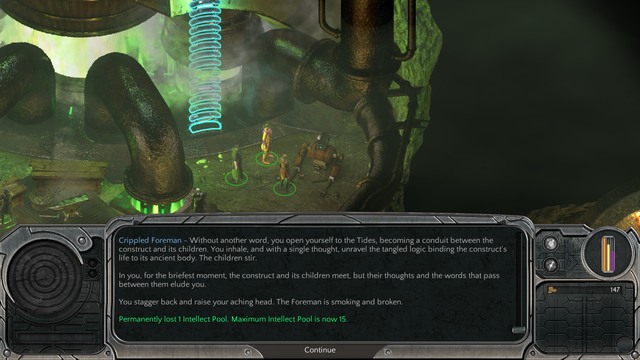
A bliss of torment
I sunk in for at least a dozen or so hours – in terms of the content, the beta is only a fraction of what will the full game offer. However, it is rich enough to give an idea of what the full game will be – and it is certainly much bigger than the alpha version that was released in the autumn.
The adventure begins just like in the previous build. The main character is falling from the skies and he has a hard landing in a mysterious room with a sarcophagus. There is also a quite long sequence in the protagonist’s mind which is a sublime way to create a character (we will discuss it later). After that we reach the most important part of the content – several districts of the city of Sagus Cliffs. This is where we spend time achieving goals of the main story or getting involved in some secondary plots while exploring that extraordinary place. Just like Sigil in Planescape: Torment, Sagus Cliffs isn’t one of these virtual cities meant to simulate a living world. Actually, it’s something like a huge gallery of curiosities, full of breathtaking views and characters only waiting to show us their unusual appearance and tell their amazing story… as well as encourage us to contemplate various philosophical and metaphysical problems, etc. There is no place for trivial NPCs and mundane questions – these things exist only in the form of unimportant background.
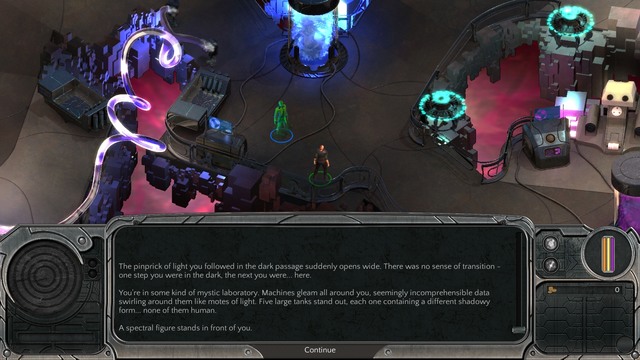
Generally, The Ninth World – a universe the game is set in – is somehow similar to Planes from Planescape… and very different at the same time. Similarity comes with fact that both universes are mixing fantasy with science-fiction, advanced technology with primitive mystique. But in The Ninth World there is no such thing as magic – or at least almost everything I saw in the beta version could be explained as a result of using some kind of science. Let me remind you that Tides of Numenera shows us Earth from a very distant future (approximately a billion years forward), which saw eight great civilizations rising and collapsing. It is now the time of the ninth civilization (that’s why we are using the name The Ninth World) which grew to pretty much medieval level using the remnants left by the previous worlds (although people usually didn’t know the purpose of these ancient devices, buildings, etc). That’s why on every step we see swords and nanobots, old-fashioned tents and force field generators, representatives of traditional social groups (like merchants or noblemen) and robots with advanced artificial intelligence, etc. The result is a universe the player drowns in after just a few minutes and then there is no coming back for many hours.
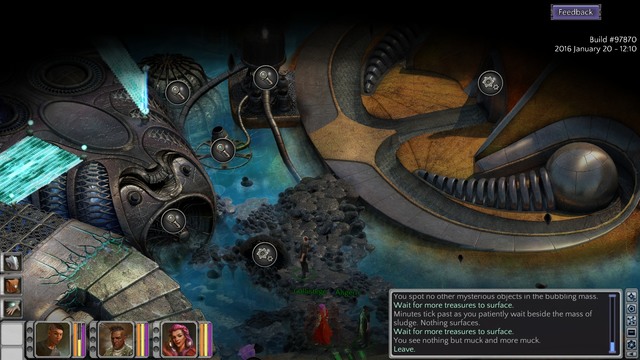

Just as promised, sometimes Torment depicts the events in the form known from gamebooks – and from Pillars of Eternity. However, inXile is using these sequences much less often than Obsidian, and they are of different character. They are more complex and used to depict long fragments of the story which are e.g. flashbacks set in different time and place than the main plot. Simple interactions which in PoE are also depicted using this gamebook (e.g. attempt to climb on the ruined watchtower in the forest), in Tides of Numenera use „normal” dialogue windows.
The story has many things in common with the old Torment. The main character, who doesn’t know who he/she is and remembers almost nothing, wakes up by a sarcophagus in a mysterious hall and meets his/her companions who better understand what’s going on. Apart from that, the Last Castoff (that’s the name of the main character) is practically immortal and he/she is able to spontaneously regain knowledge thanks to flashes of memories from hero’s previous incarnations (so to speak). However, if you are going to call Tides of Numenera a simple rip off from Planescape, then you need to know that the central point of the story is different than in the previous Torment (immortality doesn’t play any important role here). That’s why similarities don’t make you feel like playing the same game again. Or at least the fragment of the story shown in the beta didn’t make me feel like that.
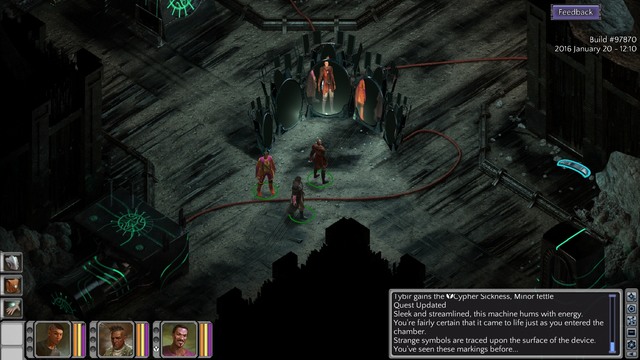
Depth of mechanical simplicity
As I mentioned, the character creation system was implemented within the prologue. The game requires us to make decisions which impact attributes, skills and other character’s statistics. In the meantime, the mechanics of the so called ”crises” (conflict situations) are introduced to the player, as well as gamebook narrative model – and all of that is subtly hidden behind fascinating introduction to the story about the Last Castoff. Of course, using choices in the narrative as a way of creating a character isn’t anything new in the RPG genre but I have never seen this process to be so softly and intuitively put within the narrative… and to be so long. At last all is summed up in a traditional window where we can see the ratio between our choices and raw numbers, and we can correct anything that doesn’t suit us. And there are no dozens of tables – at this stage just a few clicks separates us from the great adventure.
Hero’s characteristics consists of three core elements:
Descriptor – an epithet describing the character’s main attribute, e.g. Tough, Charming, Strong
Class – there are just three classes: Glaive (a warrior), Nano (”a mage”), Jack (combination of the previous two with a bit of a thief thrown in)
Focus – what the character is most known for or their special talent (e.g. Brandishes a Silver Tounge)
An example: ”Charming Nano Who Rides the Lightning”
To fully understand how good the mechanics were constructed, you would have to see it with your own eyes or at least read some complex descriptions of particular elements of it. Because it’s not the right place for such thing, I will say just one thing – although terms the game uses (e.g. Tides, Descriptors, Focus) seem to be abstract and can be confusing in the beginning, everything turns out to be pretty simple and intuitive after a while. Even the original systems don’t cause problems, like five Tides describing the hero’s personality or using three core attributes as pools of points to spend to perform various actions (in every test we decide how much effort we will put into it and, therefore, how many points we will spend affecting the chance for success). In general terms, the creators of the system artfully combined new and original elements with things well known to RPG fans (e.g. active and passive skills).
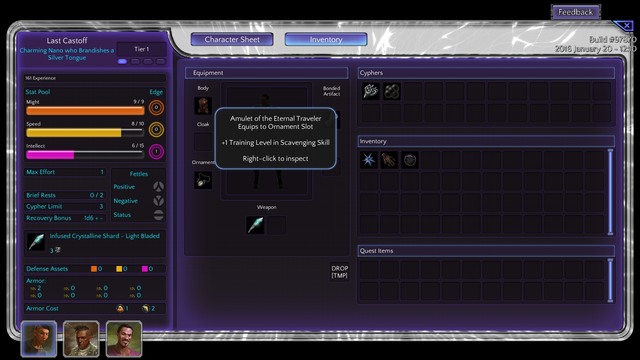
Also the combat is surprisingly intuitive. Although it is turn-based, you won’t find dozens of tactical options here – you just move your character (while observing the cursor’s color to make sure that the distance isn’t too large and it won’t prevent you from taking an action) and then you attack, use one of character’s special abilities or perform some defensive maneuver. In the meantime you can also change weapon or use a Cypher (a kind of single-use ”magical” artifact). And you are repeating that schema with all your party members turn after turn. However, it doesn’t mean that skirmishes are formulaic and repeatable – you can often turn them upside down by interacting with the surrounding objects (e.g. to release a poisonous gas) or even talking to one of your opponents in the middle of the combat (and intimidating him to surrender, for example).
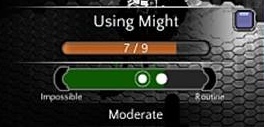
Also the system of performing tests is unusual. Its core element is rolling a 20-sided dice and comparing the result with action’s difficulty level (which depends on the character’s statistics and other factors) but it’s modified by the Effort. Every time we perform a test we decide how many points of a chosen attribute (Might, Speed or Intellect) we spend on it – the more points you choose, the better the chance to succeed. Attribute points are regenerated by resting, just like with hit points in traditional RPGs.
It must be emphasized, though, that the combat isn’t a gameplay element that the developers use very often (unless you decide to play an aggressive character). Tides of Numenera isn’t one of the RPGs which entertain the player by forcing him to fight wolves, bandits and other random enemies every 15 minutes. After what I saw in Sagus Cliffs, I am willing to believe when the developer says that each ”crisis” here is hand crafted and has a certain place in the story – and that in almost each such situation you can avoid spilling blood thanks to your smartness, persuasion, observation or other non-combat talents of the character.
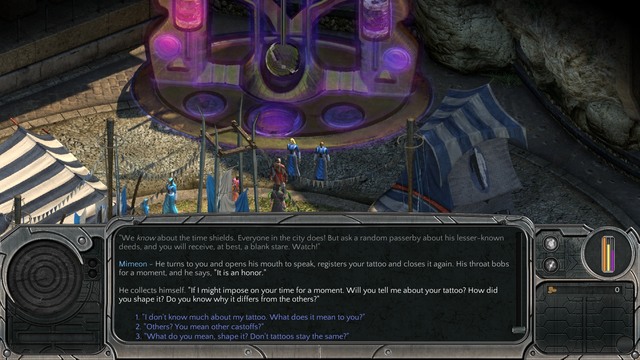
Even during the character creation you can see that combat doesn’t have to be your character’s main focus. Among skills you can gain, there are mainly various types of knowledge or talents connected to exploration, diplomacy or general manual capabilities; and these skills really affect the gameplay. Swift fingers can give you a chance to obtain some artifacts, you will avoid fight with bandits thanks to deception and with the anamnesis you will recall the language of wild creatures you are supposed to negotiate with. That allows you to approach every task in many different ways. Having created a persuasive character I was able to avoid every ”unpleasant” situation during the first ten hours of playing. Sometimes you can also use eponymous Tides to solve problems – they can be described as a kind of mysterious energy divided into five aspects of human personality (attuning to Tides and picking the one which dominates the character’s personality is the biggest part of the prologue). It is also worth mentioning that sometimes the game requires us to solve puzzles – although it is even possible to use other solutions.
Modern oldschool
As you probably already noticed looking at the screenshots, the new Torment shows unequal level in terms of graphics. On one hand, inXile has created very esthetic backgrounds for unusual locations of The Ninth World; they are also accompanied by not-too-many-but-surprisingly-nice animations and various ”special effects”, such us dynamic lighting (although some things still need to be fixed, e.g. shadows). On the other hand, the models of characters could be more detailed and in some places the user interface has too bright colors that can be pretty disturbing. Also the lack of general uniformity in the graphic style is confusing (it can be seen especially in the gamebook sequences). We can only hope that inXile will do their best and improve what they can before the final release. Soundtrack is usually kept in the background – and that’s a pity because music, when you already hear it, strongly reminds you of the tracks from Planescape: Torment, both in style and quality. Mark Morgan definitely did a great job. Other aspects of the audio are hard to be judged right now as the beta lacks many sound effects yet.
While in terms of the story, world, etc. Tides of Numenera is very promising already, the technical side of the game is far from being finished. User interface windows don’t have final shape yet and when you try to open them the game often freezes for several seconds. Gameplay balance is in its first trial (balancing will begin when players start to send their feedback). Your character can’t use all the skills yet. Sometimes framerate drops occur (below 30 FPS on good computer). Keyboard shortcuts can’t be used and the Controls section in the menu is not available yet. Naturally, there are also tons of bugs. The most serious issue I came across (four times) were the situations when the game suddenly stopped reacting to any interactions with the world, even character movement – all I could do in such cases was to restart the game. InXile didn’t even put the trade mechanics into the game yet. Every merchant, when you ask him to show you their goods, apologizes and explains that they just sold out the last item.
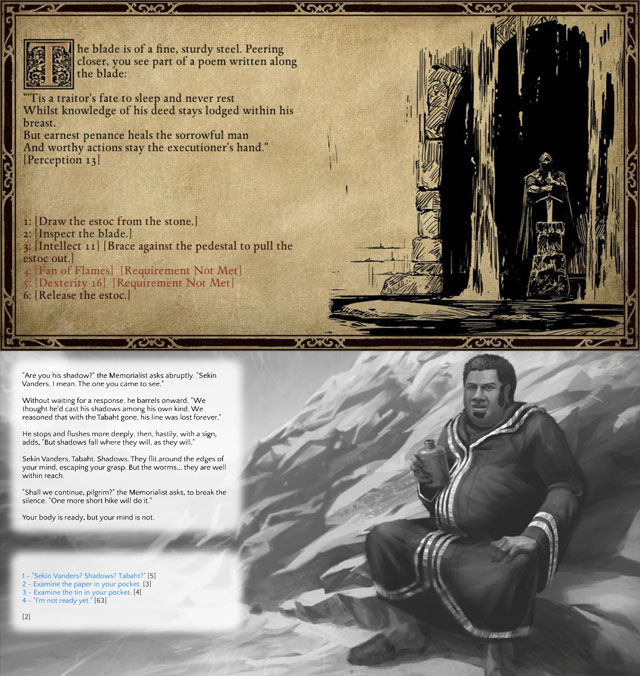
It was – and still is – worth the wait
To sum this all up, it took Tides of Numenera just a few hours to dismiss all its rivals and become the undisputed number one on my list of the most awaited games. Almost everything here is amazing – the universe, the story, the characters, the choices you make, even the mechanics. If what inXile put in the beta is representative of the whole game, we can already declare victory and claim that the search for Planescape’s worthy successor has ended. The new Torment seems to do with its predecessor what Pillars of Eternity did with Baldur’s Gate – it is an amazing tribute to the classic, but at the same time Tides of Numenera deepens everything we loved in it and makes another huge step in the evolution of the RPG genre. I know these words sound pompously but believe me, it’s hard not to be euphoric while playing Brian Fargo’s new game.
I’m more worried about the technical side of the game and its artstyle – the beta is far from being perfect, and Wasteland 2 showed that inXile isn’t on its best when dealing with this part of the production process. There’s still a lot of work for the dev team, so if you thought that releasing the beta of Tides of Numenera in Early Access is the final step before the final release of the game (that has already been delayed few times), then I’m afraid that you’re up for a disappointment. The aforementioned Wasteland 2 was in the early access for a good part of nine months and I’m afraid that Brian Fargo’s new project will meet the same fate. I really hope that I’m not right about it.
